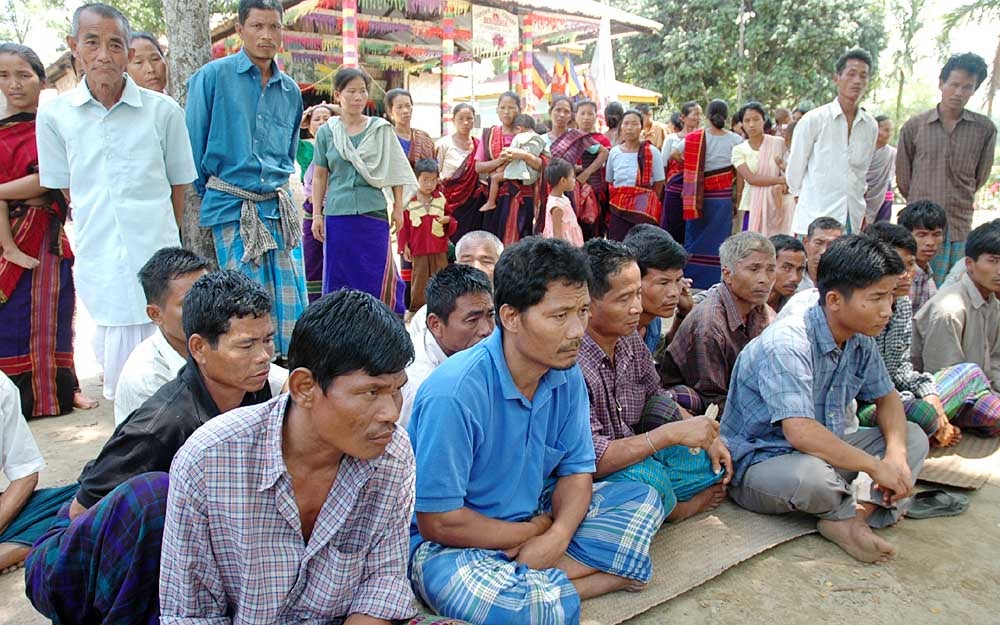About Chakmas
- Chakmas are one of the largest ethnic groups native to the Chittagong Hill Tracts (CHT) region of southeastern Bangladesh.
- They have their own age-old culture, language, and scripts.
- They primarily live in the Chittagong Hills Tracts of Bangladesh, the Chin and Arakan provinces of Myanmar, in the northeastern Indian states of Mizoram, Tripura, and Arunachal Pradesh, and a few families in West Bengal.
- Population:
- The Chakma population is estimated to be around 550,000.
- The majority (approximately 300,000 people) are located in the Chittagong Hill Tracts of Bangladesh.
- There are also about 80,000 Chakmas in Mizoram State.
- Religion:
- The majority of Chakmas practice Theravada Buddhism, tinged with aspects of animism and Hinduism.
- Every Chakma village has a Buddhist temple (kaang), and the Buddhist priests or monks are called Bhikhus.
- The Chakmas worship Hindu deities like Lakshmi, for example, is worshipped as the Goddess of the Harvest.
- Society:
- Chakmas are divided into clans (gojas), which are further subdivided into subclans (guttis).
- Members of the same subclan are forbidden to marry each other.
- Language: The Chakmas speak a dialect of Bengali (Bangla) and use the standard Bengali alphabet.
- Agricultural Practices:
- They practice shifting cultivation called JUM.
- They grow paddy, maize, cotton, sesame, etc. in their JUM, along with vegetables and spices.
- They also know the art of low-land cultivation.
Key Facts about Theravada Buddhism:
- Theravada, the “Doctrine of the Elders,” is the name for the school of Buddhism that draws its scriptural inspiration from the Pali Canon, or Tipitaka, which scholars generally accept as the oldest record of the Buddha’s teachings.
- It is one of the two major branches of Buddhism, the other being Mahayana Buddhism.
- Owing to its historical dominance in southern Asia (Sri Lanka, Thailand, and Burma), Theravada is also identified as “Southern Buddhism,” in contrast to “Northern Buddhism,” which migrated northwards from India into Tibet, China, Japan, and Korea.
- Theravada is sometimes identified as “Hinayana” (the “Lesser Vehicle”), in contradistinction to “Mahayana” (the “Greater Vehicle”), which is usually a synonym for Tibetan Buddhism.
- It is the dominant religion in Cambodia, Laos, Myanmar, Sri Lanka, and Thailand and is practiced by minorities in India, Bangladesh, China, Nepal, and Vietnam.
- In contrast to Mahayana and Vajrayana, Theravāda tends to be conservative in matters of doctrine and monastic discipline.
- Beliefs:
- Theravada Buddhism places a strong emphasis on individual spiritual striving and the pursuit of personal enlightenment (nirvana).
- Monastic life, meditation, and moral conduct are central to this path. The monastic community as a whole is called the sangha.
- Like all Buddhist traditions, Theravada Buddhism upholds the Four Noble Truths, which outline the nature of suffering (dukkha), its causes, its cessation, and the path to its cessation, which is the Eightfold Path.
- Meditation is a central practice in Theravada Buddhism. The cultivation of mindfulness (sati) and insight meditation (vipassana) are key elements of the path to enlightenment.
- Theravada Buddhists believe in the law of karma, which means that one’s actions have consequences.
Q1) What is the Buddhist Eightfold Path?
The eightfold path is Right Understanding, Right Intent, Right Speech, Right Action, Right Livelihood, Right Effort, Right Mindfulness, and Right Concentration.
Last updated on December, 2025
→ Check out the latest UPSC Syllabus 2026 here.
→ Join Vajiram & Ravi’s Interview Guidance Programme for expert help to crack your final UPSC stage.
→ UPSC Mains Result 2025 is now out.
→ UPSC Notification 2026 is scheduled to be released on January 14, 2026.
→ UPSC Calendar 2026 is released on 15th May, 2025.
→ The UPSC Vacancy 2025 were released 1129, out of which 979 were for UPSC CSE and remaining 150 are for UPSC IFoS.
→ UPSC Prelims 2026 will be conducted on 24th May, 2026 & UPSC Mains 2026 will be conducted on 21st August 2026.
→ The UPSC Selection Process is of 3 stages-Prelims, Mains and Interview.
→ UPSC Result 2024 is released with latest UPSC Marksheet 2024. Check Now!
→ UPSC Prelims Result 2025 is out now for the CSE held on 25 May 2025.
→ UPSC Toppers List 2024 is released now. Shakti Dubey is UPSC AIR 1 2024 Topper.
→ UPSC Prelims Question Paper 2025 and Unofficial Prelims Answer Key 2025 are available now.
→ UPSC Mains Question Paper 2025 is out for Essay, GS 1, 2, 3 & GS 4.
→ UPSC Mains Indian Language Question Paper 2025 is now out.
→ UPSC Mains Optional Question Paper 2025 is now out.
→ Also check Best IAS Coaching in Delhi

















